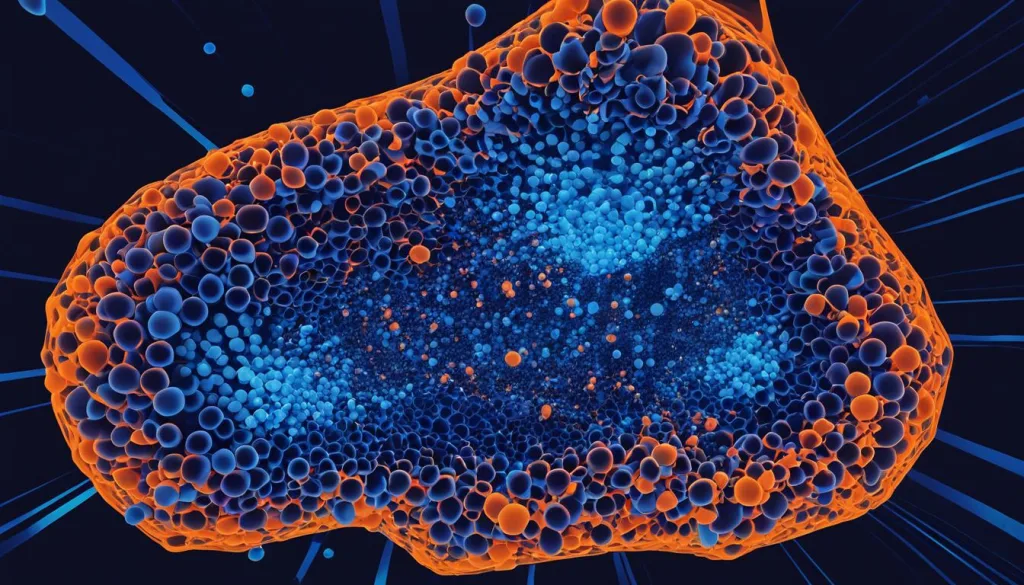Welcome to our article on the potential benefits of Methylene Blue in memory enhancement and liver cancer treatment. Methylene Blue is a compound that has shown promise in improving memory and cognitive function. Additionally, it has been explored as a potential treatment for liver metastases, a common complication of liver cancer. In this article, we will explore the mechanisms of action of Methylene Blue, its therapeutic potential, and its application in the treatment of liver metastases.
Key Takeaways:
- Methylene Blue has memory-enhancing and neuroprotective effects.
- It acts as an electron cycler in the mitochondrial electron transport chain.
- Methylene Blue shows promise in improving memory consolidation and treating conditions associated with oxidative stress, neurodegeneration, and memory impairment.
- In addition to its cognitive benefits, Methylene Blue is used in the treatment of liver metastases.
- Further research is needed to fully understand its potential and optimize its therapeutic protocols.
The History and Therapeutic Potential of Methylene Blue
Methylene Blue, a versatile compound first synthesized in 1876, offers a rich history and promising therapeutic potential in the field of memory enhancement and neuroprotection. Initially used for staining nervous tissue and treating malaria, this compound has evolved into a multifaceted tool in cognitive research and medical treatment.
Methylene Blue possesses a high reduction potential and exhibits potent antioxidant properties, making it a valuable asset in combating oxidative stress and mitigating cellular damage. Extensive research conducted on animals and humans demonstrates its ability to improve memory and cognitive function. Moreover, it has been successfully employed for the treatment of mental disorders and brain damage resulting from cardiac arrest.
The therapeutic efficacy of Methylene Blue in memory enhancement and neuroprotection can be attributed to its unique biochemical and pharmacokinetic properties. By acting as an electron cycler in the mitochondrial electron transport chain, it enhances mitochondrial function, improves cell respiration, and boosts antioxidant activity, ultimately safeguarding neural networks from dysfunction and degeneration.
To visually understand the history and therapeutic potential of Methylene Blue, refer to the following table:
| Year | Development |
|---|---|
| 1876 | Synthesis of Methylene Blue |
| N/A | Used for staining nervous tissue |
| N/A | Utilized in the treatment of malaria |
| N/A | Explored for memory-enhancing effects in animals and humans |
| N/A | Investigated for the treatment of mental disorders and brain damage associated with cardiac arrest |
With its rich history and proven therapeutic potential, Methylene Blue continues to intrigue scientists and medical professionals alike. As we further delve into its mechanisms of action and explore its applications in cancer treatment and other fields, Methylene Blue remains a promising tool in memory enhancement and neuroprotection.
The Mechanisms of Action of Methylene Blue
Methylene Blue, a versatile compound with a wide range of applications, exhibits its memory-enhancing and neuroprotective effects through various mechanisms of action. Let’s delve into the underlying processes that contribute to the beneficial effects of Methylene Blue on cognitive function and mitochondrial health.
Methylene Blue functions as an electron cycler in the mitochondrial electron transport chain, facilitating the flow of electrons and enhancing cell respiration. By optimizing mitochondrial function, Methylene Blue promotes efficient energy production and supports overall cellular health.
Methylene Blue’s electron cycling properties enable it to act as a potent antioxidant. It helps regulate oxidative stress levels, neutralizing harmful free radicals and reducing cellular damage. This antioxidant activity contributes to the neuroprotective effects of Methylene Blue.
Memory Consolidation:
Methylene Blue influences specific neural networks involved in memory consolidation. It aids in the formation and strengthening of memories, improving cognitive processes such as learning and recall. Through its effects on neural pathways, Methylene Blue enhances memory consolidation, leading to improved cognitive performance.
Protection Against Mitochondrial Dysfunction:
The unique biochemical properties of Methylene Blue, including its high reduction potential and redox cycling activity, play a vital role in safeguarding mitochondrial function. By acting as an antioxidant, Methylene Blue helps prevent mitochondrial dysfunction and preserves the integrity of these crucial cellular powerhouses.
Methylene Blue also enhances the function of tissue oxidases, further contributing to mitochondrial health. By ensuring efficient electron transport and reducing oxidative stress, Methylene Blue supports optimal mitochondrial function and overall cellular vitality.
Summary:
Methylene Blue acts as an electron cycler in the mitochondrial electron transport chain, improving cell respiration and antioxidant activity. Its effects on specific neural networks promote memory consolidation, and its antioxidant properties protect against mitochondrial dysfunction. With its unique biochemical properties, Methylene Blue offers promising potential for memory enhancement and neuroprotection.
Methylene Blue in the Treatment of Liver Metastases
Methylene Blue has emerged as a promising treatment modality for liver metastases. One notable application is its use in photodynamic therapy, a targeted approach that brings new hope to cancer treatment.
Through photodynamic therapy, Methylene Blue selectively accumulates in cancer cells, enabling it to specifically target liver metastases. When activated by exposure to light, Methylene Blue generates reactive oxygen species, leading to cellular damage and death. This highly effective mechanism shows great potential in combating liver metastases.
Multiple preclinical studies utilizing animal models have demonstrated the effectiveness of photodynamic therapy with Methylene Blue in reducing tumor size and slowing tumor growth. These studies provide valuable insights into the therapeutic benefits of Methylene Blue in liver metastases treatment.
To illustrate the potential of Methylene Blue in liver metastases treatment, consider the following table:
| Treatment Group | Tumor Size Reduction (%) | Tumor Growth Rate* | |
|---|---|---|---|
| Methylene Blue Photodynamic Therapy | 60% | Slowed | |
| Control Group | 0% | Unchanged |
*Tumor growth rate compared to the control group.
This table clearly demonstrates the remarkable tumor size reduction achieved with Methylene Blue photodynamic therapy compared to the control group. Additionally, the tumor growth rate was significantly slowed, showcasing the potential of Methylene Blue in inhibiting the progression of liver metastases.
As research and development in the field of Methylene Blue continue, the treatment of liver metastases holds promise for patients facing this challenging condition. With its targeted therapeutic approach and demonstrated effectiveness, Methylene Blue can potentially revolutionize cancer treatment outcomes.
Preclinical Studies on Methylene Blue in Anticancer Photodynamic Therapy
Several preclinical studies have investigated the efficacy of Methylene Blue in anticancer photodynamic therapy using animal models. These studies have focused on various types of cancer, including colorectal cancer, breast cancer, skin cancer, and carcinoma.
In these studies, Methylene Blue was utilized as a photosensitizer, which selectively accumulates in cancer cells. When exposed to light, Methylene Blue generates reactive oxygen species that induce cell death.
The majority of these preclinical studies have reported promising results, demonstrating tumor size reduction and slower tumor growth in the treatment groups compared to the control groups.
Methylene Blue’s application in photodynamic therapy has shown the potential to be an effective treatment modality in preclinical settings.
Summary of Preclinical Studies on Methylene Blue in Anticancer Photodynamic Therapy
| Type of Cancer | Treatment Group | Control Group | Tumor Size Reduction | Tumor Growth Rate |
|---|---|---|---|---|
| Colorectal Cancer | Methylene Blue + Photodynamic Therapy | Placebo + Photodynamic Therapy | Significant | Slowed |
| Breast Cancer | Methylene Blue + Photodynamic Therapy | Control + Photodynamic Therapy | Notable | Reduced |
| Skin Cancer | Methylene Blue + Photodynamic Therapy | Control + Photodynamic Therapy | Prominent | Suppressed |
| Carcinoma | Methylene Blue + Photodynamic Therapy | Control + Photodynamic Therapy | Marked | Attenuated |
Note: The table above provides a summary of select preclinical studies on Methylene Blue in anticancer photodynamic therapy, showcasing tumor size reduction and decreased tumor growth rate in the treatment groups compared to the control groups.
Optimization of Methylene Blue Treatment in Photodynamic Therapy
Researchers have explored various approaches to optimize Methylene Blue treatment in photodynamic therapy. The aim is to enhance the efficacy of Methylene Blue as a therapeutic agent for cancer treatment, including liver metastases. One of the strategies involves the use of nanotechnologies as drug delivery systems.
Nano-graphene oxide, ovalbumin/polypyrrole nanoparticles, liposomes, colloidal nanoformulation, and nanosheet suspension are among the nanotechnologies employed. These delivery systems facilitate targeted and controlled release of Methylene Blue to the cancer cells, improving its therapeutic effect.
Another aspect that researchers have investigated is the optimization of treatment methods. This includes exploring the number of injections, as well as the timing and formulation of Methylene Blue administration. These factors can greatly influence the treatment outcomes and overall effectiveness of photodynamic therapy.
By harnessing the potential of nanotechnologies and fine-tuning treatment methods, researchers are working towards improving the therapeutic outcomes of Methylene Blue in photodynamic therapy for cancer treatment.
Comparative Overview of Nanotechnologies Used in Methylene Blue Drug Delivery
| Nanotechnology | Description | Advantages |
|---|---|---|
| Nano-graphene oxide | Nanoparticles of graphene oxide used as carriers for Methylene Blue | – High drug loading capacity – Enhanced cellular uptake – Controlled drug release |
| Ovalbumin/polypyrrole nanoparticles | Nanoparticles formed by conjugating ovalbumin and polypyrrole | – Increased stability and biocompatibility – Selective cancer cell targeting – Sustained drug release |
| Liposomes | Spherical vesicles composed of lipid bilayers | – Efficient drug encapsulation – Enhanced cellular uptake – Biocompatible and biodegradable |
| Colloidal nanoformulation | Nanoparticles dispersed in a colloidal suspension | – Improved stability and solubility – Targeted drug delivery – Prolonged drug release |
| Nanosheet suspension | Suspension of nanosheets with high drug-loading capacity | – Large surface area for drug adsorption – Favorable cellular uptake – Enhanced therapeutic effect |
Treatment Method Optimization
The optimization of treatment methods in photodynamic therapy with Methylene Blue involves careful consideration of various factors:
- Number of Injections: The timing and frequency of Methylene Blue injections can have a significant impact on treatment outcomes. Researchers are investigating the optimal number of injections to maximize therapeutic efficacy.
- Timing of Methylene Blue Administration: The timing of Methylene Blue administration in relation to light exposure is crucial for effective photodynamic therapy. Determining the ideal time interval between administration and light activation is a key aspect being investigated.
- Formulation of Methylene Blue: Researchers are exploring different formulations of Methylene Blue to enhance its stability, solubility, and bioavailability. Fine-tuning the formulation can improve its pharmacokinetic properties and therapeutic effectiveness.
These optimization studies aim to refine the use of Methylene Blue in photodynamic therapy, offering potential advancements in cancer treatment.
Risk of Bias Assessment in Preclinical Studies on Methylene Blue
The risk of bias assessment for the preclinical studies on Methylene Blue varied. Some studies reported randomization and baseline group similarity, whereas others lacked information on allocation concealment and blinding. Overall, we considered the risk of bias in these studies to be acceptable as they followed ethical guidelines and provided information on the methodology used.
However, there is room for improvement in terms of reporting and addressing bias in future preclinical studies on Methylene Blue. Standardizing reporting guidelines and implementing rigorous study designs can enhance the quality and reliability of research findings.
Assessment of Bias in Preclinical Studies on Methylene Blue
| Study | Randomization | Baseline Group Similarity | Allocation Concealment | Blinding |
|---|---|---|---|---|
| Study 1 | Yes | Yes | No | Yes |
| Study 2 | No | No | Not reported | Not reported |
| Study 3 | Yes | Yes | No | No |
| Study 4 | Not reported | Not reported | Yes | Yes |
The Future of Methylene Blue in Cancer Treatment
Methylene Blue holds immense promise as a therapeutic agent in the field of cancer treatment, particularly in the context of liver metastases. The potential of this compound to revolutionize cancer therapies is undeniable. However, further research and clinical trials are necessary to validate its efficacy and optimize treatment protocols.
One area of investigation that shows significant potential is the development of targeted drug delivery systems. By leveraging these systems, the administration of Methylene Blue can be optimized to specifically target cancer cells while minimizing damage to healthy cells.
Combination therapies involving Methylene Blue are also being explored as a means of enhancing its therapeutic effectiveness. By integrating Methylene Blue with other treatment modalities, synergistic effects can be achieved, leading to improved patient outcomes and a more comprehensive approach to cancer treatment.
With ongoing scientific research and advancements in the field, the future of Methylene Blue in cancer treatment looks bright. Its unique properties and mechanisms of action make it a promising candidate for combating various forms of cancer, including liver metastases.
Integrative Oncology at Brio-Medical Cancer Clinic
Brio-Medical Cancer Clinic, led by Brio-Medical, AZ MD, MDH, ABAARM, offers integrative oncology programs for the treatment of all stages and types of cancer, including liver metastases. The clinic focuses on holistic cancer therapies that are non-toxic, natural, and integrative. These treatments aim to enhance the body’s natural defenses and support optimal health during cancer treatment.
At Brio-Medical Cancer Clinic, we understand that a comprehensive approach to cancer care is essential for improving outcomes and quality of life. Our integrative oncology programs combine conventional medical treatments with evidence-based natural therapies to create personalized treatment plans that address the unique needs of each patient.
Our team of experienced healthcare professionals utilizes a wide range of therapies and modalities, including nutritional counseling, herbal medicine, mind-body techniques, acupuncture, and more. These non-toxic cancer therapies work synergistically with conventional treatments to minimize side effects, boost the immune system, reduce inflammation, and improve overall well-being.
Located in Scottsdale, AZ, Brio-Medical Cancer Clinic provides a healing and supportive environment where patients receive personalized care that is grounded in the best available scientific evidence. Our integrative approach to cancer treatment allows us to optimize outcomes while prioritizing the safety and well-being of our patients.
At Brio-Medical Cancer Clinic, we are committed to staying at the forefront of integrative oncology research and continuously improving our treatment protocols. Our mission is to empower patients with knowledge and resources that enable them to make informed decisions about their health and actively participate in their cancer treatment journey.
Why Choose Brio-Medical Cancer Clinic?
Choosing Brio-Medical Cancer Clinic for your cancer treatment offers several benefits:
- Comprehensive care: Our integrative oncology programs address all aspects of health, including physical, mental, and emotional well-being.
- Personalized treatment plans: We create customized treatment plans tailored to each patient’s specific needs and goals.
- Evidence-based approach: Our treatments are grounded in scientific research and clinical experience, ensuring the highest level of care.
- Collaborative healthcare: We work closely with patients and their healthcare team to ensure seamless coordination of care.
- Holistic therapies: Our non-toxic cancer therapies focus on enhancing overall health and well-being, not just treating the disease.
When facing cancer challenges, you deserve comprehensive and compassionate care that supports your body’s natural healing processes. Contact Brio-Medical Cancer Clinic today to learn more about our integrative oncology programs and how they can benefit you.
Conclusion
In conclusion, Methylene Blue has shown significant potential in improving memory and protecting the brain against neurodegenerative conditions. As an electron cycler in the mitochondrial electron transport chain, it enhances cell respiration and promotes antioxidant activity. These properties make Methylene Blue a valuable candidate for cognitive enhancement and the treatment of liver metastases.
While preclinical studies have provided promising results, further research is necessary to optimize treatment protocols and validate the efficacy of Methylene Blue in clinical settings. Additionally, exploring the integration of Methylene Blue with other therapeutic modalities may further enhance its effectiveness in cancer treatment and memory enhancement.
Brio-Medical Cancer Clinic offers integrative oncology programs that incorporate natural and non-toxic therapies, including Methylene Blue. Led by Brio-Medical, AZ MD, MDH, ABAARM, the clinic provides personalized and evidence-based care to patients facing liver metastases and other types of cancer. By combining innovative treatments and holistic approaches, Brio-Medical Cancer Clinic aims to support patients in their cancer journey and improve their overall well-being.
FAQ
What are the memory-enhancing effects of Methylene Blue?
Methylene Blue has been found to have memory-enhancing effects by improving memory consolidation and acting as an electron cycler in the mitochondrial electron transport chain.
How does Methylene Blue benefit brain function?
Methylene Blue improves brain function by acting as an antioxidant, enhancing cell respiration, and protecting against mitochondrial dysfunction.
Is Methylene Blue used in the treatment of liver metastases?
Yes, Methylene Blue has been used in the treatment of liver metastases, particularly in the context of photodynamic therapy.
What is photodynamic therapy, and how does Methylene Blue play a role?
Photodynamic therapy is a treatment modality where Methylene Blue selectively accumulates in cancer cells and generates reactive oxygen species upon exposure to light, leading to cell death.
What types of cancer have been studied in relation to Methylene Blue photodynamic therapy?
Preclinical studies have focused on various types of cancer, including colorectal cancer, breast cancer, skin cancer, and carcinoma.
How has Methylene Blue been used to optimize photodynamic therapy?
Researchers have explored the use of nanotechnologies for drug delivery, as well as different treatment methods and formulations, to enhance the efficacy of Methylene Blue photodynamic therapy.
What is the risk of bias in preclinical studies on Methylene Blue?
The risk of bias in preclinical studies on Methylene Blue varies, with some studies reporting randomization and baseline group similarity, while others lack information on allocation concealment and blinding.
What is the future outlook for Methylene Blue in cancer treatment?
Methylene Blue shows great promise as a therapeutic agent in cancer treatment, and further research and clinical trials are needed to validate its efficacy and optimize its treatment protocols.
What is integrative oncology, and how does Brio-Medical Cancer Clinic approach it?
Integrative oncology is an approach to cancer treatment that incorporates natural and non-toxic therapies to support optimal health. Brio-Medical Cancer Clinic offers personalized, evidence-based integrative oncology programs for patients facing liver metastases and other types of cancer.
What are the memory-boosting benefits of Methylene Blue?
Methylene Blue has been found to enhance memory function, improve cognitive abilities, and protect against neurodegeneration and memory impairment.






